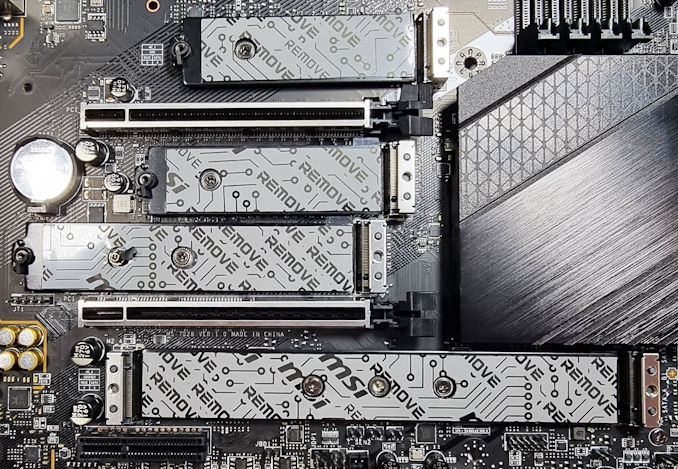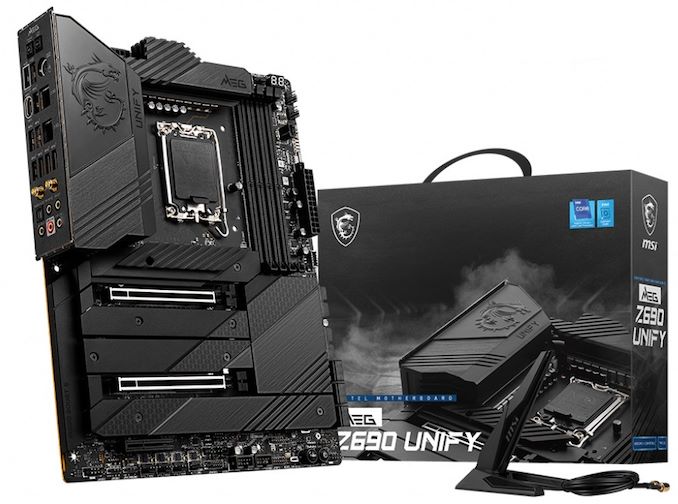The MSI MEG Z690 Unify (DDR5) Motherboard Review: The All-Black Option
by Gavin Bonshor on January 18, 2022 10:00 AM ESTConclusion
Along with the launch of Intel's 12th generation processors came a new socket (LGA1700), new features such as PCIe 5.0, support for DDR5 memory, and a new hybrid core architectural design. Intel also launched its Z690 chipset, and along with it, all of the motherboard vendors combined launched over 80+ new models for users to select from. More than 50 of these new Z690 models support DDR5, while more than 30 are available for users planning to use DDR4 memory. This means users now have more choices in terms of motherboard availability than there ever has been before on a single chipset. While many users across the internet have complained about how expensive some of these 'premium' and flagship models cost upwards of $1000, at Newegg, prices start at $210 for the DDR4 models and $230 for the DDR5 models (at the time of writing).
One of the models aiming to capture the imagination of users looking to build a premium Alder Lake system for either performance or gaming in a turbulent market is the MSI MEG Z690 Unify. A representative of its premium MEG (Enthusiast Gaming) series, the Z690 Unify combines an all-black RGBless aesthetic with some gnarly features designed to make it a solid all-around option on paper.
Starting off with some of the main features, it includes support for DDR5-6666 memory (128 GB over four slots), which despite still being in its infancy, is likely to be something we see more as Intel improves on its memory controller and memory manufacturers find the sweet spot in the manufacturing process. Other notable features include five M.2 slots, with four offering support for PCIe 4.0 x4 and one with PCIe 3.0 x4 bandwidth, while MSI also has two full-length slots with support for PCIe 5.0 x16 or x8/x8, while MSI also includes a half-length slot that is locked down to PCIe 3.0 x4.
MSI also includes a decent controller set, with two Intel I225-V 2.5 GbE controllers offering one Ethernet port each on the rear panel and an Intel AX210 Wi-Fi 6E CNVi making the most of Intel integrated PHY on the chipset. Other utilized features of Z690 by MSI here include two USB 3.2 G2x2 Type-C ports, with one on the rear panel and one via a front panel header, along with a stack of seven USB 3.2 G2 Type-A ports, all of which are on the rear panel. This is plenty of high-speed connectivity for users with many USB devices and those with devices that can utilize the extra bandwidth offered by G2. Onboard audio options include a Realtek ALC4080 HD audio codec, which powers five 3.5 mm audio jacks and S/PDIF optical output on the rear.
Touching on the performance, the MSI MEG Z690 Unify is competitive against similar models that we've tested so far, but we do have plenty of Z690 models to compare against it in the future. As it stands, the Z690 Unify did well in our system, compute, and gaming testing, with competitive POST time, solid DPC latency, and decent power consumption figures. We observed no weird anomalies during any part of our testing with this board.

I heard you like M.2, so I put some storage in your storage...
In our overclocking and VRM thermal testing, the MSI MEG Z690 Unify showed that it could do well under the pressure of plenty of CPU VCore and frequency applied to our Core i9-12900K's P-cores. For overclocking, the Z690 Unify is a solid contender with its large 21-phase (19+2) power delivery operating in a 19+1 configuration with premium 105 A power stages throughout. We did notice some overzealous levels of VDroop on the CPU V-Core. Still, despite running into thermal limitations, we managed to achieve an all P-Core stable overclock of 5.3 GHz, which undoubtedly caused thermal throttling. The VRM thermals of the Z690 Unify were also competitive, and we have no doubts that with more aggressive CPU cooling, there's even more potential to be squeezed out of Alder Lakes silicon.
Final Thoughts: Is a $490 Z690 Board Mid-range, Premium, or Overpriced?
When it comes to justifying the price of Z690 motherboards, there's been a lot of furore from users on the internet since the launch of Z690 around the vendor's current pricing. I agree with the point that motherboard pricing has progressively increased with each generation. The fact is, so have other components, technologies, and it has always been the case that having the best just inherently costs more. The problem isn't really at the upper end of the stack with expensive flagships, but the cost of what users consider to be entry-level and mid-range—even looking at one of the cheapest Z690 models available, priced at $210. Unfortunately, it doesn't really cater to 'entry-level' users anymore. For a more affordable entry point onto Alder Lake, a whole host of B660, H670, and H610 models are available.
Focusing on the MSI MEG Z690 Unify, it has an MSRP of $490 and is currently available at Newegg for this price. In terms of competition, there's the ASRock Z690 PG Velocita ($470), the ASUS ROG Strix Z690-E Gaming WIFI ($470), and the GIGABYTE Z690 Aorus Master ($470). Aside from the Z690 Aorus Master, which offers 10 GbE, the MSI is the next best in terms of networking with dual 2.5 GbE on the rear panel and Wi-Fi 6E and support for five M.2 drives. Much of the feature sets across all of the models mentioned above are pretty much the same.
Summarising the MSI MEG Z690 Unify up, it's a competitive model at the $450-500 price point for users looking to push Intel's Alder Lake processors above and beyond its already impressive performance at stock. The Unify is more than worthy of consideration for users looking for a premium foundation for an Intel 12th gen and DDR5 performance-focused system from the premium power delivery, solid network array, and many rear panel USB 3.2 G2 ports.











20 Comments
View All Comments
mrvco - Tuesday, January 18, 2022 - link
I embrace our post Peak RGB world.meacupla - Tuesday, January 18, 2022 - link
MSI VRMs running a bit warmer than the competition seems to be pretty normal.I just wish they would use heatsinks with more surface area.
erinadreno - Wednesday, January 19, 2022 - link
agree. People have figured out they should use finned aluminum/copper as heatsinks on CPU. Why couldn't they apply this knowledge on to the VRMolde94 - Wednesday, January 19, 2022 - link
yeah it's almost as if larger surface area helps!Oxford Guy - Friday, January 21, 2022 - link
Tons of boards in the past had VRM sinks with lots of pure metal fins. Some even had copper heatpipes to connect to multiple heavy-duty highly-finned sinks.HollyDOL - Wednesday, January 19, 2022 - link
no RGB? Sold!JamesWoods - Monday, January 24, 2022 - link
You know you can just turn most RGBs off...right?Mikehawkest - Sunday, March 27, 2022 - link
Stfu and go watch Barney.PeachNCream - Friday, January 21, 2022 - link
No RGB is good, but its still far more sensible to buy a budget computing equipment which is already RGB-free and use modest hardware for much lower cost and then you can squirrel away the difference in cost to upgrade more frequently and leap ahead in performance without bothering with overclocking, high wattage PSUs, or loads of waste heat. Or just set your expectations a bit lower and find a way to kill time on lesser, more efficient hardware. For instance, I still do most of my gaming on a Celeron n3060 in a purple HP Stream 11 running Linux and kill off just as many hours being just as amused as someone that spent vastly more money and feeds orders of magnitude more power to their PC. - And I don't have RGB lighting AND I can easily take my computer somewhere else with me rather than being stuck in a fixed location with a stationary, wired-to-the-wall desktop.Badelhas - Saturday, January 22, 2022 - link
What kind of games do you play?